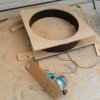From rotocasters, vacuum formers and degassing chambers to jigs, setups and CNC equipment, if you've built it to facilitate a build, post it. You can include as much info on the build as you wish...

Here's my offering... My CNC Router

way overbuilt, with heavy-duty steel frame, 2cm thick aluminum plates, 25mm & 20mm roller bearings, 2.2kW water cooled spindle controlled via VFD and Mach 3. It cost me roughly $1700 in parts and materials and took a month to build. The design was based on other routers I saw online and modified to my needs... the work envelope is (X)500mm x (Y)600mm x (Z)210mm. I don't have normal blueprints for this as I just used basic sketches to fabricate it. There was an issue of backlash that I traced back to the flexible coupler. I made a solid coupler and resolved the issue. The dedicated PC is running windows XP and is completely isolated from any internet connection.

Here's my offering... My CNC Router
way overbuilt, with heavy-duty steel frame, 2cm thick aluminum plates, 25mm & 20mm roller bearings, 2.2kW water cooled spindle controlled via VFD and Mach 3. It cost me roughly $1700 in parts and materials and took a month to build. The design was based on other routers I saw online and modified to my needs... the work envelope is (X)500mm x (Y)600mm x (Z)210mm. I don't have normal blueprints for this as I just used basic sketches to fabricate it. There was an issue of backlash that I traced back to the flexible coupler. I made a solid coupler and resolved the issue. The dedicated PC is running windows XP and is completely isolated from any internet connection.












